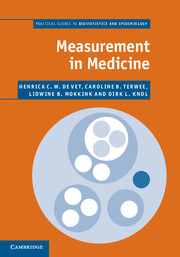Book contents
- Frontmatter
- Contents
- Preface
- 1 Introduction
- 2 Concepts, theories and models, and types of measurements
- 3 Development of a measurement instrument
- 4 Field-testing: item reduction and data structure
- 5 Reliability
- 6 Validity
- 7 Responsiveness
- 8 Interpretability
- 9 Systematic reviews of measurement properties
- References
- Index
4 - Field-testing: item reduction and data structure
Published online by Cambridge University Press: 07 September 2011
- Frontmatter
- Contents
- Preface
- 1 Introduction
- 2 Concepts, theories and models, and types of measurements
- 3 Development of a measurement instrument
- 4 Field-testing: item reduction and data structure
- 5 Reliability
- 6 Validity
- 7 Responsiveness
- 8 Interpretability
- 9 Systematic reviews of measurement properties
- References
- Index
Summary
Introduction
Field-testing of the measurement instrument is still part of the development phase. When a measurement instrument is considered to be satisfactory after one or more rounds of pilot-testing, it has to be applied to a large sample of the target population. The aims of this field-testing are item reduction and obtaining insight into the structure of the data, i.e. examining the dimensionality and then deciding on the definitive selection of items per dimension. These issues are only relevant for multi-item instruments that are used to measure unobservable constructs. Therefore, the focus of this chapter is purely on these measurement instruments. Other newly developed measurement instruments (e.g. single-item patient-reported outcomes (PROs)) and instruments to measure observable constructs go straight from the phase of pilot-testing to the assessment of validity, responsiveness and reliability (see Figure 3.1).
- Type
- Chapter
- Information
- Measurement in MedicineA Practical Guide, pp. 65 - 95Publisher: Cambridge University PressPrint publication year: 2011
- 9
- Cited by



